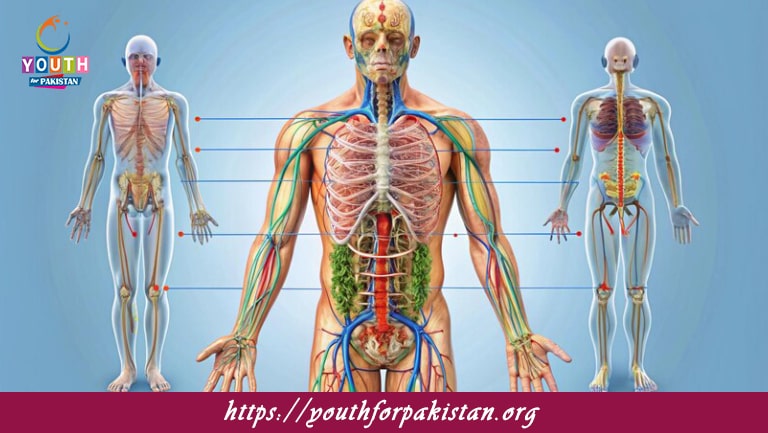Welcome to the Human Body and Anatomy MCQs with Answers. In this post, we are sharing Human Body and Anatomy Multiple Choice Questions and Answers in Everyday Science section for various competitive exams in Pakistan. Each question offers a chance to enhance your knowledge regarding Human Body and Anatomy online MCQs Test.
Which organ is primarily responsible for filtering blood in the human body?
A) Kidney
B) Liver
C) Heart
D) Lungs
Which part of the brain controls voluntary movements?
A) Cerebrum
B) Cerebellum
C) Brainstem
D) Thalamus
Which type of joint is found in the shoulder and hip?
A) Ball-and-socket joint
B) Hinge joint
C) Pivot joint
D) Saddle joint
Which organ produces insulin?
A) Pancreas
B) Liver
C) Heart
D) Stomach
Which blood vessel carries oxygen-rich blood from the heart to the body?
A) Artery
B) Vein
C) Capillary
D) Aorta
Which part of the eye controls the amount of light that enters?
A) Iris
B) Retina
C) Cornea
D) Lens
Which bone is the longest in the human body?
A) Femur
B) Humerus
C) Tibia
D) Radius
Which system in the body is responsible for the exchange of gases?
A) Respiratory system
B) Digestive system
C) Circulatory system
D) Nervous system
Which part of the heart receives oxygen-poor blood from the body?
A) Right atrium
B) Left atrium
C) Right ventricle
D) Left ventricle
Which gland is known as the “master gland” because it regulates other endocrine glands?
A) Pituitary gland
B) Thyroid gland
C) Adrenal gland
D) Pancreas
Which part of the digestive system is primarily responsible for nutrient absorption?
A) Small intestine
B) Stomach
C) Large intestine
D) Esophagus
Which muscle is primarily responsible for breathing?
A) Diaphragm
B) Biceps
C) Triceps
D) Quadriceps
Which of the following bones is found in the arm?
A) Humerus
B) Femur
C) Tibia
D) Ulna
Which organ is responsible for producing bile?
A) Liver
B) Pancreas
C) Gallbladder
D) Kidney
Which part of the brain is responsible for regulating heartbeat and breathing?
A) Brainstem
B) Cerebrum
C) Cerebellum
D) Thalamus
Which hormone regulates metabolism and is produced by the thyroid gland?
A) Thyroxine
B) Insulin
C) Adrenaline
D) Estrogen
Which structure in the human body connects muscles to bones?
A) Tendons
B) Ligaments
C) Cartilage
D) Joints
Which of the following is the largest organ in the human body?
A) Skin
B) Liver
C) Heart
D) Lung
Which blood cells are responsible for fighting infections?
A) White blood cells
B) Red blood cells
C) Platelets
D) Plasma
Which part of the body is the primary site for the production of red blood cells?
A) Bone marrow
B) Liver
C) Spleen
D) Lungs
Which of the following is not a function of the liver?
A) Producing bile
B) Metabolizing drugs
C) Regulating blood sugar
D) Filtering lymph
Which part of the human body contains the cochlea, responsible for hearing?
A) Inner ear
B) Outer ear
C) Middle ear
D) Sinuses
Which part of the body protects the spinal cord?
A) Vertebrae
B) Ribs
C) Sternum
D) Pelvis
Which type of muscle is found in the walls of internal organs and is involuntary?
A) Smooth muscle
B) Skeletal muscle
C) Cardiac muscle
D) Striated muscle
Which part of the body helps to regulate body temperature?
A) Hypothalamus
B) Pituitary gland
C) Thalamus
D) Medulla
Which organ is responsible for detoxifying harmful substances in the body?
A) Liver
B) Kidney
C) Heart
D) Lung
Which structure in the human body is responsible for producing and secreting hormones that control growth and development?
A) Endocrine glands
B) Digestive glands
C) Exocrine glands
D) Lymph nodes
Which of the following is the primary function of the large intestine?
A) Absorption of water
B) Digestion of proteins
C) Absorption of nutrients
D) Production of bile
Which part of the human body connects the throat to the stomach?
A) Esophagus
B) Trachea
C) Bronchi
D) Duodenum
Which organ is involved in the production of red and white blood cells and platelets?
A) Spleen
B) Liver
C) Kidney
D) Pancreas
Which bone forms the forehead?
A) Frontal bone
B) Parietal bone
C) Occipital bone
D) Temporal bone
Which type of connective tissue connects bone to bone?
A) Ligaments
B) Tendons
C) Cartilage
D) Adipose tissue
Which organ system includes the heart and blood vessels?
A) Circulatory system
B) Respiratory system
C) Digestive system
D) Nervous system
Which part of the body is responsible for controlling reflex actions?
A) Spinal cord
B) Brain
C) Heart
D) Lungs
Which of the following is the main component of the skin that provides elasticity?
A) Collagen
B) Elastin
C) Keratin
D) Melanin
Which of the following bones is found in the skull?
A) Sphenoid
B) Femur
C) Tibia
D) Radius
Which part of the human body helps in the production of sound?
A) Larynx
B) Trachea
C) Bronchi
D) Pharynx
Which of the following is the primary function of red blood cells?
A) Oxygen transport
B) Immune response
C) Blood clotting
D) Nutrient absorption
Which part of the body is responsible for regulating the body’s internal environment?
A) Homeostasis
B) Endocrine system
C) Nervous system
D) Digestive system
Which organ is responsible for producing digestive enzymes and hormones such as insulin?
A) Pancreas
B) Liver
C) Stomach
D) Small intestine
Which type of tissue covers the body surface and lines cavities?
A) Epithelial tissue
B) Connective tissue
C) Muscle tissue
D) Nervous tissue
Which organ is responsible for detoxification and metabolism of nutrients and drugs?
A) Liver
B) Kidney
C) Heart
D) Lungs
Which part of the human body helps in regulating body temperature?
A) Skin
B) Liver
C) Kidneys
D) Muscles
Which bone forms the base of the skull and supports the spinal column?
A) Occipital bone
B) Temporal bone
C) Parietal bone
D) Frontal bone
Which part of the human body contains the alveoli for gas exchange?
A) Lungs
B) Heart
C) Stomach
D) Liver
Which of the following is the main function of the large intestine?
A) Water absorption
B) Nutrient absorption
C) Digestion of proteins
D) Storage of bile
Which of the following glands is responsible for producing sweat?
A) Sweat glands
B) Sebaceous glands
C) Thyroid gland
D) Pituitary gland
Which type of blood vessel carries blood away from the heart?
A) Artery
B) Vein
C) Capillary
D) Venule
Which of the following is the smallest bone in the human body?
A) Stapes
B) Femur
C) Humerus
D) Tibia
Which organ system includes the brain and spinal cord?
A) Nervous system
B) Circulatory system
C) Respiratory system
D) Digestive system
Which part of the eye contains photoreceptors for vision?
A) Retina
B) Cornea
C) Iris
D) Lens
Which organ is responsible for the production of hormones such as adrenaline?
A) Adrenal gland
B) Pancreas
C) Thyroid gland
D) Pituitary gland
If you are interested to enhance your knowledge regarding Physics, Chemistry, Computer, and Biology please click on the link of each category, you will be redirected to dedicated website for each category.










